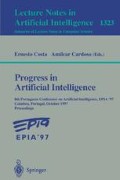Abstract
Most people would agree that a formalisation of granularity in natural language should involve notions of abstraction and detail. However in reality, this concept has proved difficult to capture formally. In this paper we examine the role of granularity in constructing explanations. This role is clarified by providing several dimensions along which any explanation task can be characterised. We argue that a combination of these dimensions can be used to define a notion of coherence in texts. This notion of coherence gives rise to search heuristics when solving nontrivial language engineering problems such as reference resolution.
Preview
Unable to display preview. Download preview PDF.
References
Eugene Charniak and Drew McDermott. Introduction To Artificial Intelligence. Addison-Wesley, 1985.
Jerry R. Hobbs, Mark E. Stickel, Douglas E Appels, and Paul Martin. Intrepretation as abduction. Artificial Intelligence, 63:69–142, 1993.
David B. Leake. Focusing construction and selection of abductioe hypotheses. In Proceedings of the Eleventh International Joint Conference on Artificial Intelligence, pages 24–29, Chambéry, France, 1993.
Derek Long and Roberto Garigliano. Reasoning by Analogy and Causality: A model and application. Artificial Intelligence. Ellis Horwood, 1994.
Richard Morgan, Roberto Garigliano, Paul Callaghan, Sanjay Poria, Mark Smith, Agnieszka Urbanowicz, Russell Collingham, Marco Costantino, Chris Cooper, and the LOLITA Group. Description of the lolita system as used in muc-6. In The Sixth Message Understanding Conference, pages 71–87, Nov 1995.
R. C. Schank and R. P. Abelson. Scripts, Plans, Goals and Understanding. Erlbaum, 1977.
Author information
Authors and Affiliations
Editor information
Rights and permissions
Copyright information
© 1997 Springer-Verlag Berlin Heidelberg
About this paper
Cite this paper
Poria, S., Garigliano, R. (1997). Granularity for explanation. In: Coasta, E., Cardoso, A. (eds) Progress in Artificial Intelligence. EPIA 1997. Lecture Notes in Computer Science, vol 1323. Springer, Berlin, Heidelberg. https://doi.org/10.1007/BFb0023936
Download citation
DOI: https://doi.org/10.1007/BFb0023936
Published:
Publisher Name: Springer, Berlin, Heidelberg
Print ISBN: 978-3-540-63586-4
Online ISBN: 978-3-540-69605-6
eBook Packages: Springer Book Archive

